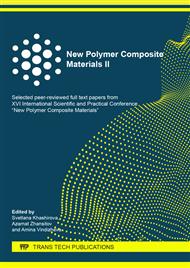[1]
E.M. Petrie, Handbook of adhesives and sealants. (2005).
Google Scholar
[2]
E. Sancaktar, Classification of adhesive and sealant materials, V. 1-2, (2018).
Google Scholar
[3]
FEICA-ASC-CATIA. Adhesive & Sealants classification manual. Edition, (2012).
Google Scholar
[4]
M.S. Perova, R.Y. Galimzyanova, Y.N. Khakimullin, S.I. Vol'fson, Influence of the Molecular Weight of Oligoisobutylenes on the Properties of Uncured Sealants, Int. Polym. Sci. Technol. 38 (2011) 9-11.
DOI: 10.1177/0307174x1103801203
Google Scholar
[5]
L.I. Murtazina, A.R. Garifullin, I.A. Nikul'tsev, R.F. Fatkhullin, R.Y. Galimzyanova, Y.N. Khakimullin, The influence of calcium carbonate on the properties of noncuring sealants based on ethylene propylene diene monomer rubber and thermoplastics, Polym. Sci. Ser. D. 8 (2015) 199-202.
DOI: 10.1134/s1995421215030090
Google Scholar
[6]
R.Y. Galimzyanova, M.S. Lisanevich, Y.N. Khakimullin, Effect of calcium carbonate on the properties of noncuring sealants based on butyl rubber and thermoplastics, Russ. J. Appl. Chem. 86 (2013) 1287-1291.
DOI: 10.1134/s1070427213080223
Google Scholar
[7]
A.R. Akhmedgoraeva, A.A. Stytsenkov, R.Y. Galimzyanova, Y.N. Khakimullin, The Influence of Thickness and Reinforcement on the Properties of Sealing Tapes of Incongealable Type on the Basis of Butyl Rubber Depending on the Nature of the Glued Substrate, Polym. Sci. Ser. D. 12 2019. 137-141.
DOI: 10.1134/s1995421219020035
Google Scholar
[8]
I.A. Starostina, O.V. Stoyanov, N.V. Makhrova, D.A. Nguen, E.V. Perova, M.S. Galimzyanova, R.Y. Burdova, Y.N. Khakimullin, Application of the acid-base approach to explain adhesive properties of modified rubber coatings, Polym. Sci. Ser. D. 5 (2012) 89-91.
DOI: 10.1134/s1995421212020141
Google Scholar
[9]
L.Y. Zakirova, S.I. Vol'fson, Y.N. Khakimullin, Determination of the surface free energy of thermoelastoplastic-modified bitumen, Polym. Sci. Ser. C. 49 (2007) 149-151.
DOI: 10.1134/s1811238207020105
Google Scholar
[10]
E.S. Il'icheva, A.D. Khusainov, High-molecular-weight modifiers with graft anhydride and imide groups: effect on the adhesion, rheological, and physicomechanical properties of rubber compounds, Int. Polym. Sci. Technol. 42 (2015) 117-120.
DOI: 10.1177/0307174x1504200604
Google Scholar
[11]
O. Figovsky, E. Gotlib, E. Ilicheva, A. Mokeev, Super deep penetration - new method of nanoreinforced composites producing based on polymer matrixes». Sci. Isr. Technol. Advantages. 14 (2012) 74-78.
Google Scholar
[12]
M.S. Perova, A.M. Makasheva, Y.N. Khakimullin, Influence of Maleic Anydrate on Properties of Incongealable Sealants based on Butyl Rubber, Polym. Sci. Ser. D. 4 (2011) 125-128.
DOI: 10.1134/s1995421211020122
Google Scholar
[13]
E.M. Petrie, Reactive hot-melt adhesives for better structural bonding, Met. Finish. 106 (2008) 39-43.
DOI: 10.1016/s0026-0576(08)80125-0
Google Scholar
[14]
V. Carrera, M. García-Morales, F.J. Navarro, P. Partal, C. Gallegos, Bitumen chemical foaming for asphalt paving applications», Ind. Eng. Chem. Res. 49 (2010) 8538-8543.
DOI: 10.1021/ie101136f
Google Scholar
[15]
US6803412. Moisture curable hot melt sealants for glass constructions.
Google Scholar
[16]
M.S. Lisanevich, R.Y. Galimzyanova, S.N. Rusanova, Y.N. Khakimullin, O.V. Stoyanov, Hot-Melt Sealants of Curable Type Based on Butyl Rubber and Ethylene-Vinyl Acetate Copolymer, Polym. Sci. Ser. D. 11 (2018) 359-362.
DOI: 10.1134/s1995421218040135
Google Scholar


